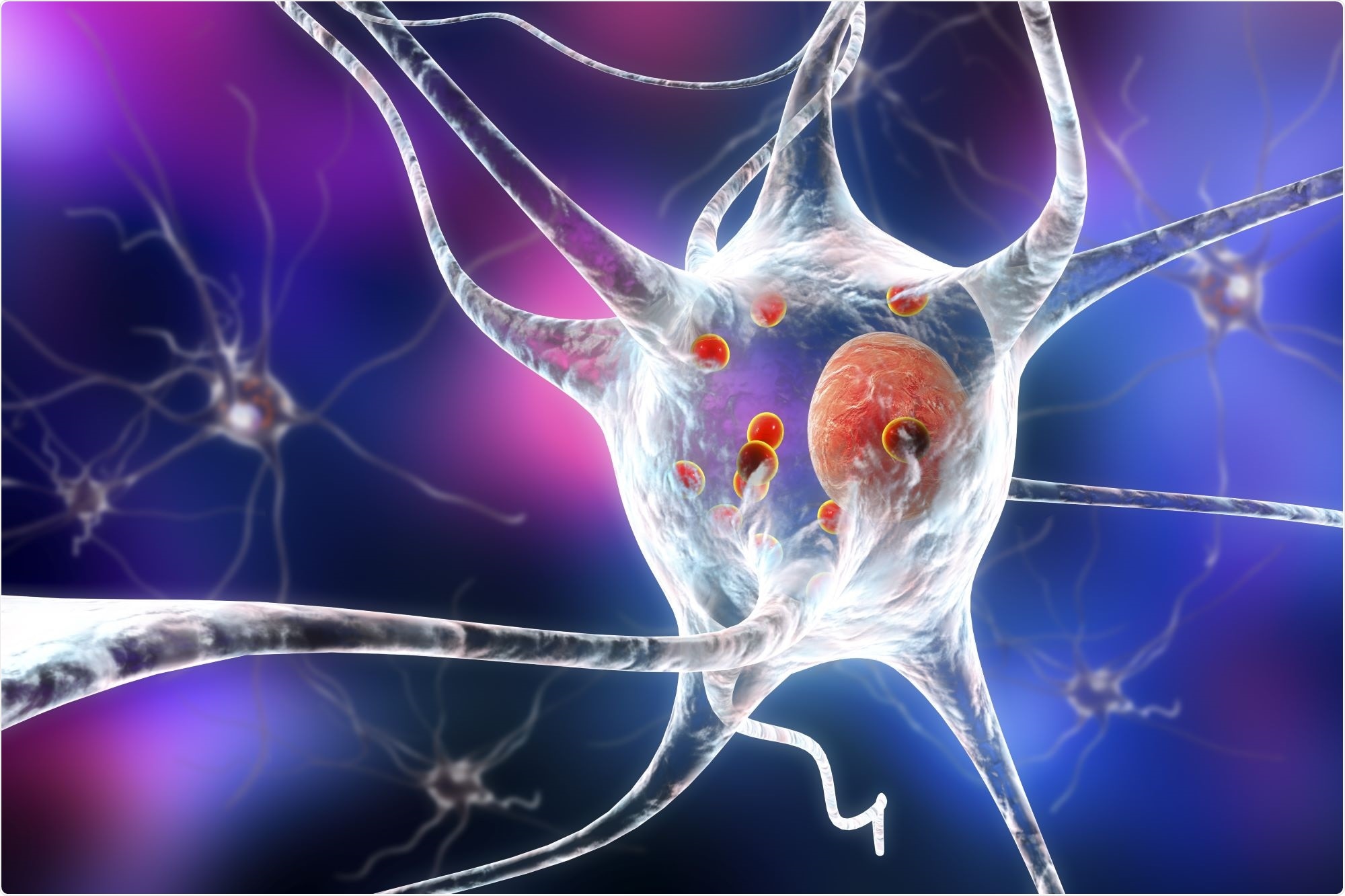Researchers have made a “vital step” toward inferring the origins of Parkinson’s disease—a neurological condition that is rapidly growing in the world.

3D illustration showing neurons containing Lewy bodies small red spheres which are deposits of proteins accumulated in brain cells that cause their progressive degeneration. Top image: Degeneration of dopaminergic neuron, a key stage of development of Parkinson's disease, 3D illustration. Image Credit: Kateryna Kon via Shutterstock.
Published in the Nature Communications journal on February 10th, 2021, a new study provides compelling new evidence about the actual function of a crucial protein, known as alpha-synuclein, in the brain neurons.
This study could unlock more information about this debilitating neurodegenerative disorder that can leave people unable to walk and talk. If we want to cure Parkinson’s, first we need to understand the function of alpha-synuclein, a protein present in everyone’s brains. This research is a vital step towards that goal.”
Dr Giuliana Fusco, Study Lead Author and Research Fellow, St John’s College, University of Cambridge
Parkinson’s disease is known to be a progressive neurological disease that causes the brain nerve cells to become weak or die. This disorder is characterized by a wide range of symptoms, such as slowness, tremors—specifically in the hands—gait and balance issues, and severe stiffness in the legs and arms.
Parkinson’s disease occurs when brain cells stop functioning properly and unable to produce adequate dopamine—a chemical that regulates the body’s movement by serving as a messenger between cells.
Parkinson’s disease mainly affects people above 60 and becomes worse over a number of years; however, early onset of Parkinson’s disease can also affect even younger people.
Globally, over 10 million individuals are affected by Parkinson’s disease, including singer Neil Diamond, actor Michael J. Fox who was diagnosed at age 29, musician Ozzy Osbourne, and comedian Billy Connolly. While Parkinson’s disease can also affect the female population, men are more likely to have this disorder.
Scientists are still clueless why people get Parkinson’s disease, but they believe that it is a combination of genetic, age, and environmental factors that cause the dopamine-releasing nerve cells to die and thus influence the body’s ability to move.
The new research work set out to find out the mechanism that was happening inside healthy conditions to identify what exactly is going wrong in the cells of individuals with Parkinson’s disease. A plasma membrane found in all cells in the body protects cells, generally carries nutrients in, and eliminates toxic substances.
“One of the top questions in Parkinson’s research is: what is the function of alpha-synuclein, the protein that under pathological conditions forms clumps that affect motor and cognitive abilities?,” explained Dr. Fusco.
Usually you discover a protein for its function and then you explore what is going wrong when disease strikes, in the case of alpha-synuclein the protein were identified for its pathological association but we didn’t know what it did in the neuron. Our research suggests that the alpha-synuclein protein sticks like glue to the inner face of the plasma membrane of nerve cells but not to the outer– a crucial new piece of information.”
Dr Giuliana Fusco, Study Lead Author and Research Fellow, St John’s College, University of Cambridge
The study was mainly performed at the Cambridge for Misfolding Diseases at the University of Cambridge. The team employed synthetic models to emulate the brain cells membranes during the research work.
When this protein is functioning normally it plays an important part in the mechanisms by which neurons exchange signals in the brain. But it has a dark side because it malfunctions and begins to stick together in clumps which eventually spread and kill healthy brain cells.”
Alfonso De Simone, Study Author and Professor, Imperial College London
Professor De Simone continued, “Our research showed that this protein clings onto the inner face of the plasma membrane of brain cells so we are slowly building a picture of this very complex disorder by studying the key function of alpha-synuclein.”
Drugs and treatments are available to patients with Parkinson’s disease and this condition is not fatal, but to date, nothing is available to reverse the disease effects. Adopting lifestyle changes, such as getting more exercise and rest, can also ease symptoms.
“We have thousands of proteins in our bodies and until the function of this mystery protein is confirmed with more research, drug therapies cannot begin to be developed to tackle the origins of Parkinson’s Disease in case medication accidentally affect a crucial purpose of the alpha-synuclein protein,” Professor De Simone concluded.
Source:
Journal reference:
Man, W. K., et al. (2021) The docking of synaptic vesicles on the presynaptic membrane induced by α-synuclein is modulated by lipid composition. Nature Communications. doi.org/10.1038/s41467-021-21027-4.